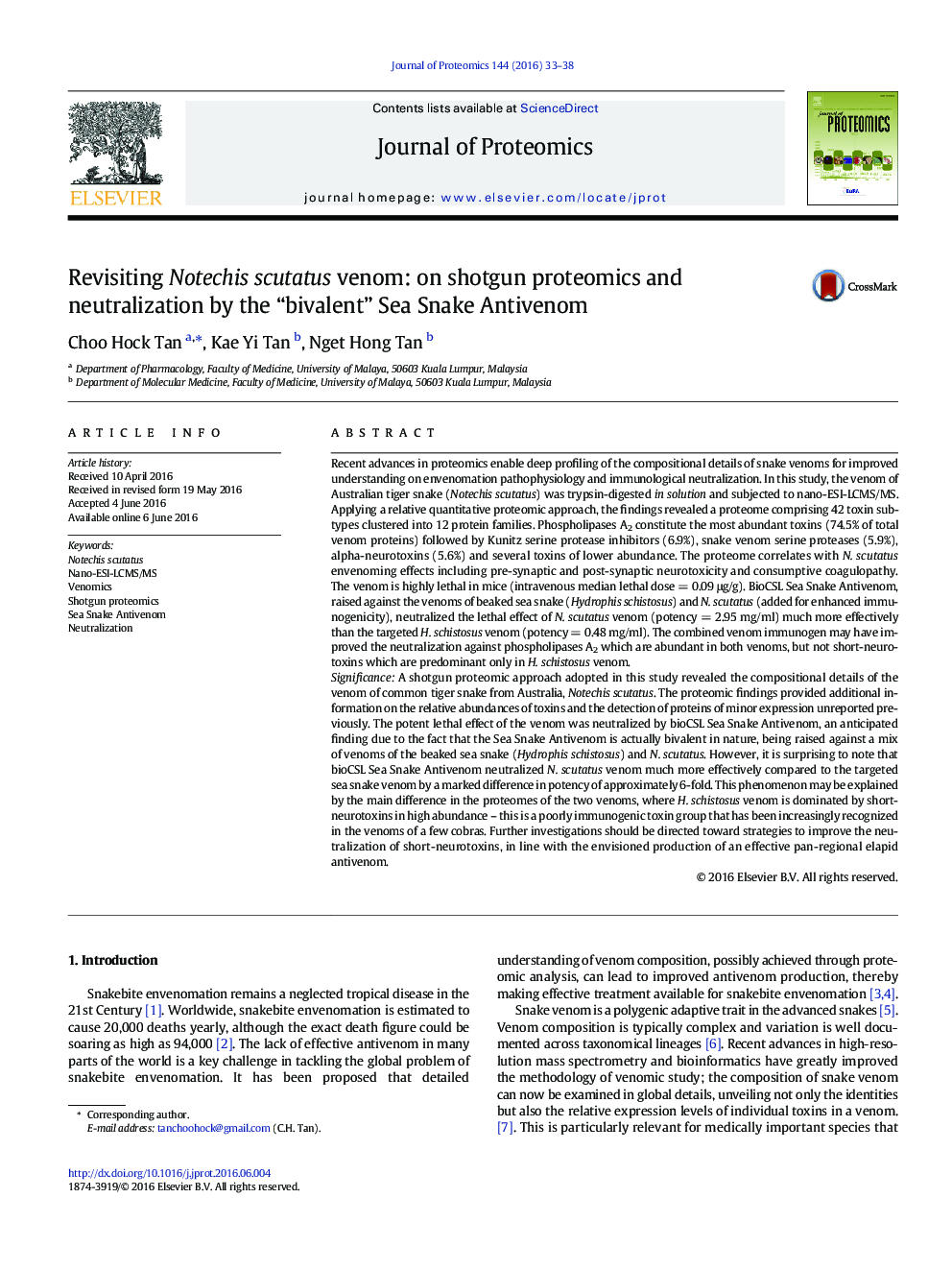| کد مقاله | کد نشریه | سال انتشار | مقاله انگلیسی | نسخه تمام متن |
|---|---|---|---|---|
| 1225122 | 1494737 | 2016 | 6 صفحه PDF | دانلود رایگان |
• Venom of Notechis scutatus (Australian tiger snake) was subjected to LCMS/MS study.
• Shotgun proteome revealed 42 toxins in 12 protein families.
• Phospholipases A2: most abundant, followed by serine proteases, alpha neurotoxins.
• Sea Snake Antivenom neutralized both venoms of tiger snake and sea snake.
• Neutralization potency for N. scutatus was 6-fold higher than for sea snake venom.
Recent advances in proteomics enable deep profiling of the compositional details of snake venoms for improved understanding on envenomation pathophysiology and immunological neutralization. In this study, the venom of Australian tiger snake (Notechis scutatus) was trypsin-digested in solution and subjected to nano-ESI-LCMS/MS. Applying a relative quantitative proteomic approach, the findings revealed a proteome comprising 42 toxin subtypes clustered into 12 protein families. Phospholipases A2 constitute the most abundant toxins (74.5% of total venom proteins) followed by Kunitz serine protease inhibitors (6.9%), snake venom serine proteases (5.9%), alpha-neurotoxins (5.6%) and several toxins of lower abundance. The proteome correlates with N. scutatus envenoming effects including pre-synaptic and post-synaptic neurotoxicity and consumptive coagulopathy. The venom is highly lethal in mice (intravenous median lethal dose = 0.09 μg/g). BioCSL Sea Snake Antivenom, raised against the venoms of beaked sea snake (Hydrophis schistosus) and N. scutatus (added for enhanced immunogenicity), neutralized the lethal effect of N. scutatus venom (potency = 2.95 mg/ml) much more effectively than the targeted H.schistosus venom (potency = 0.48 mg/ml). The combined venom immunogen may have improved the neutralization against phospholipases A2 which are abundant in both venoms, but not short-neurotoxins which are predominant only in H. schistosus venom.SignificanceA shotgun proteomic approach adopted in this study revealed the compositional details of the venom of common tiger snake from Australia, Notechis scutatus. The proteomic findings provided additional information on the relative abundances of toxins and the detection of proteins of minor expression unreported previously. The potent lethal effect of the venom was neutralized by bioCSL Sea Snake Antivenom, an anticipated finding due to the fact that the Sea Snake Antivenom is actually bivalent in nature, being raised against a mix of venoms of the beaked sea snake (Hydrophis schistosus) and N. scutatus. However, it is surprising to note that bioCSL Sea Snake Antivenom neutralized N. scutatus venom much more effectively compared to the targeted sea snake venom by a marked difference in potency of approximately 6-fold. This phenomenon may be explained by the main difference in the proteomes of the two venoms, where H. schistosus venom is dominated by short-neurotoxins in high abundance – this is a poorly immunogenic toxin group that has been increasingly recognized in the venoms of a few cobras. Further investigations should be directed toward strategies to improve the neutralization of short-neurotoxins, in line with the envisioned production of an effective pan-regional elapid antivenom.
Figure optionsDownload high-quality image (214 K)Download as PowerPoint slide
Journal: Journal of Proteomics - Volume 144, 20 July 2016, Pages 33–38
